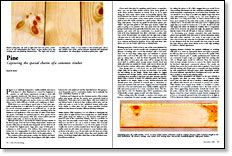
Synopsis: Jon Arno says the theory that pine is only a wood for beginners to practice on is wrong. He says there is a right pine for any project based on the wood’s structural properties or its traditional use. He talks about the limitations and applications of the more than 30 native North American species, which he divides into three main groups: white pine, western yellow pine, and southern yellow pine. Arno explains grades of pine (side information discusses how to understand grade stamps), how to work with it, and how to prepare for and apply finishes, distressed or not.
Pine is so relatively inexpensive, readily available and easy to work that it is often dismissed as a wood for beginners to practice on until they’re experienced enough to work with more expensive hardwoods. This theory is wrong. Pine is a very respectable cabinet wood with a long tradition in American furniture-making. And although some species of pine are easily worked, others can be fairly difficult to handle and a nightmare to finish.
While there is no such thing as “good” pine or “bad” pine, generally speaking there is a right pine for any given project based on the wood’s structural properties or its traditional use. To get the most out of pine, therefore, you must know something about the limitations and applications of the more than 30 native North American species. Fortunately, for practical purposes, these species can be divided into three main groups: white pine, western yellow pine and southern yellow pine, as shown in the photo above.
Although white pine is structurally the weakest and least durable of the three groups, it has the best working characteristics. Eastern and western white pine are virtually interchangeable and are ideal woods for colonial New England pieces. Sugar pine, a type of white pine, is a pleasure to work because of its uniform, fine texture and sweet aroma, but it is inappropriate for period reproductions due to the large, dark resin canals that produce flecks in the grain pattern.
The southern yellow pine group contains the hardest and heaviest of the pines. These pines have showy figures with high contrast between the soft earlywood and the hard latewood. This group is most frequently used as construction timber, but is authentic for some antebellum furniture as well.
Ponderosa and lodgepole are the dominant species of the western yellow pine group, and are the species most commonly found at lumberyards. These pines have a tamer figure, with more earlywood and thinner bands of latewood than southern yellow pine, and are softer and easier to work In fact, unfinished western yellow pine looks similar to white pine, but the abrupt transition between earlywood and latewood requires different finishing techniques.
From Fine Woodworking #79
For the full article, download the PDF below:
Fine Woodworking Recommended Products

DeWalt 735X Planer

AnchorSeal Log and Lumber End-Grain Sealer

Ridgid R4331 Planer





















Comments
I've recently rediscovered pine and I'm a much happier fella because of it! Living in Michigan, I can get some pretty good stuff and I can't deny they fun of working with your "state tree!" Underrated for sure!
Log in or create an account to post a comment.
Sign up Log in